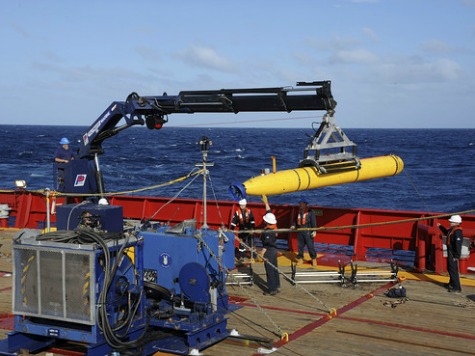The U.S. Navy is deploying an underwater drone in the Indian Ocean as the search for missing Malaysia Airlines Flight 370 heads into the deep. With investigators believing the black box emitting radio “pings” all week has died, new evidence has surfaced that dramatic fluctuations in the plane’s altitude were intended to avoid radar.
According to The Independent, a new report in The Sunday Times cites an unnamed source who described the radar information on the missing plane as violent from the minute the plane disappeared. It was “thrown around like a fighter jet,” from 45,000 feet to as low as 5,000 feet, to avoid radar, the report states.
That the jet managed to fly so low has led many to believe a report in the New Straits Times this weekend that co-pilot Fariq Abdul Hamid made a final, “desperate” phone call after the plane disappeared. The newspaper notes that the incident described was a “reattachment” between the telephone and the satellite network, which could simply mean that the phone was turned back on, not necessarily that a call was made. The Malaysian government has denied this allegation.
Malaysian acting Minister of Transport Hishammuddin Hussein tweeted Monday that there was nothing new to report on the search for the missing plane. Updates have been focused on the change in the nature of the search, rather than any findings. After last week’s breakthroughs in recording a series of sounds radiating at a frequency that could only be an airplane’s flight recorder or black box, Australian officials leading the search reduced the area to the smallest ever. No new pings have been recorded for days, however, likely indicating that the battery on the black box has died. Black box batteries are designed to last 30 days; the ping was first recorded past the 30th day of the plane’s disappearance.
The loss of the signal has triggered a decision to send Bluefin-21, an underwater drone provided by the U.S. Navy, into the deep underwater in search of any debris. Given the darkness in the ocean depths, the robot will rely on sonar to detect any unusual items on the sea floor, returning with lights and a camera should it send to the surface news of findings. Air Chief Marshal Angus Houston, who is leading the international search effort, told media Sunday that the search is expected to be long and tedious. The robot uses sonar to paint images of the ocean as quickly as possible in hopes that any key findings do not drift out of location before search teams can bring them to the surface.
The Bluefin was launched late Monday, and Houston warned it could be days or weeks before the deployment yielded any results. He noted, nonetheless, that “this is the best lead we have and it must be pursued vigorously.”

COMMENTS
Please let us know if you're having issues with commenting.